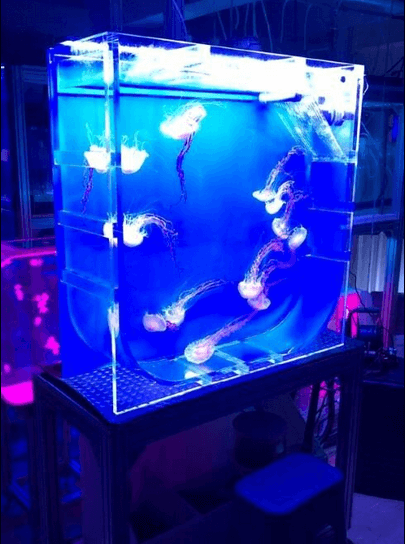Is it easy to keep jellyfish?
Well, the answer is both yes and no. It is easy to keep jellyfish because they do not require precise water quality like other aquatic animals do such as corals, and they can adapt to a wide range of environmental conditions. However, it is also not easy to keep jellyfish because there are still many unknown factors that can affect the growth or survival of jellyfish. In other words, the husbandry of jellyfish is not fully established yet, which makes the keeping of jellyfish challenging.
What do jellyfish eat?
There are two types of jellyfish, one with many short and thin tentacles such as moon jellyfish (Aurelia aurtita) and blue blubbers (Catostylus mosaicus) which feed on small marine plankton, and another with long and strong tentacles such as sea nettles and lion’s mane jellyfish which feed on small shrimp, fish and other jellyfish. In captivity, jellyfish are fed by freshly hatched live Artemia nauplii (baby brine shrimp) for short tentacles ones, and chopped up moon jellyfish or frozen sea food for long tentacle jellyfish. Preparing these foods for the jellyfish is the most challenging part of keeping jellyfish for those who want to keep them at home.
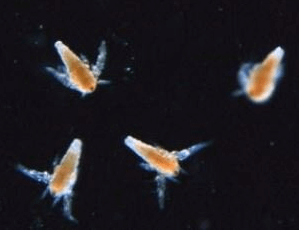
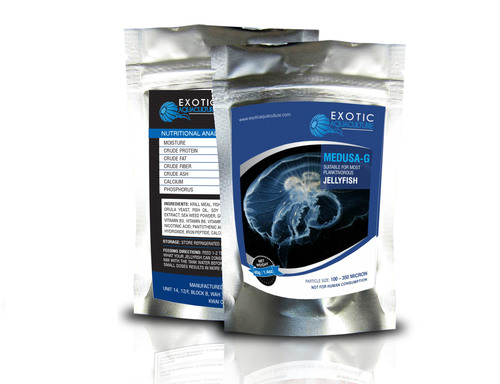
There are few dry foods for jellyfish available on the market. We did not try all of them but the use of them for most jellyfish seems very limited. We also developed a powder food for jellyfish called “Medusa-G”. This food can keep and grow moon jellyfish without adding any other food. It can be used as additional food for other type of jellies such as blubbers or sea nettles, but you will still need to feed them live brine shrimps. We also tried to feed jellyfish with various coral food in both liquid and powder forms available on the market but none of them are satisfactory.
Aquarium for jellyfish
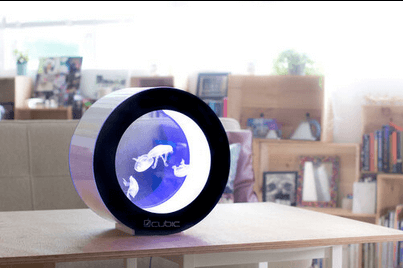
What is a jellyfish aquarium? Are they different to normal fish tanks? There are a few retail jellyfish aquariums available on the market such as Cubic Aquarium Systems’ Orbit20 or Pulse80, or Jellyfish Art tanks. All those jellyfish aquariums are designed to achieve three somehow contradicting needs of jellyfish, which are 1) they need a circular water flow so that they can stay in the water column without sinking to the bottom of the aquarium, 2) there is no strong water suction so they don’t get sucked away, and 3) they do not like any air bubbles inside the aquarium.
I said it is contradicting because to have water flow inside the aquarium, you need a water inlet, which means there is water suction. You cannot use an air bubbler either as jellyfish do not like the air bubbles. For this reason, jellyfish aquarium needs to have a spray bar which sprays the water inside the aquarium to make the circular flow, and a suction area large enough to spread out the water suction to avoid jellyfish being sucked away. A good jellyfish aquarium has a spray bar positioned in front of the suction area, which blows jellyfish away from the suction which results in an even less chance of them getting sucked.
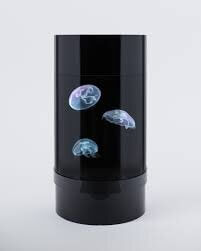
Water parameters for jellyfish
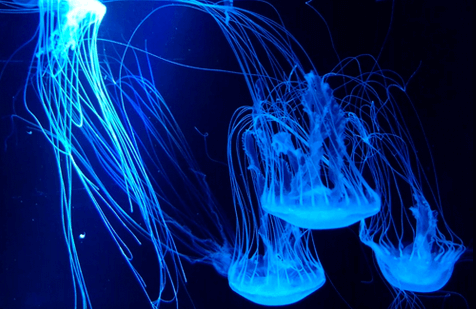
In general, jellyfish can adapt to a wide range of water parameters. I would say this is the easiest part of jellyfish keeping. For example, moon jellyfish can adapt to the salinity from 10 – 35PSU and the temperature from 5 – 24 degree Celsius (for temperate strain). It seems that jellyfish has more tolerance to the lower side of both salinity and temperature. As they are such simple creatures, they can just slow down their metabolism and survive when the temperature is too low. Also some jellyfish do better in lower salinity such as Atlantic sea nettles (Chrysaora quinquecirrha) and flame jellyfish (Rhopilema esculentum), probably due to their original living habitats.
There are no specific requirements for other water parameters. I have just listed them here for your reference.
pH: 7.6-8.5
Ammonia: <0.1ppm
Nitrite: <0.2ppm
Nitrate: <20.0ppm
Phosphate: <2.0ppm
Lights for jellyfish
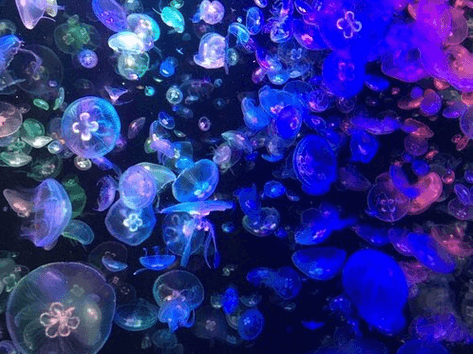
When you think of a jellyfish aquarium, you would probably imagine jellyfish beautifully illuminated in different colours. Some people may think that jellyfish can glow themselves, but except for Crystal jellyfish (Auequorea sp.), jellyfish do not glow by themselves but just reflect off the lights. This is why RGB colour changing LED lights are normally used for a jellyfish aquarium. Jellyfish with creamy white body such as moon jellyfish, marble jellyfish (Lychnorhiza lucerna) and Atlantic sea nettles get illuminated best with those RGB lights. White lights normally do best with jellyfish with some colour on them already such as blue blubbers, Pacific sea nettles (Chrysaora fuscescens) and flame jellyfish.
There are some jellyfish that require lights for photosynthesis such as the upside-down jellyfish (Cassiopeia sp.), Spotted lagoon jellyfish (Mastigias papua) and Australian spotted jellyfish (Phyllorhiza punktata). They have symbiotic algae (Zoothanthellae) inside their body, which produces and gives energy to their host like corals. For those jellyfish, you will need a full spectrum light which is strong enough to grow LPS coral (200-300PAR). Even they have symbiotic algae in their body, it is important to feed them daily with live baby Artemia for their healthy growth.
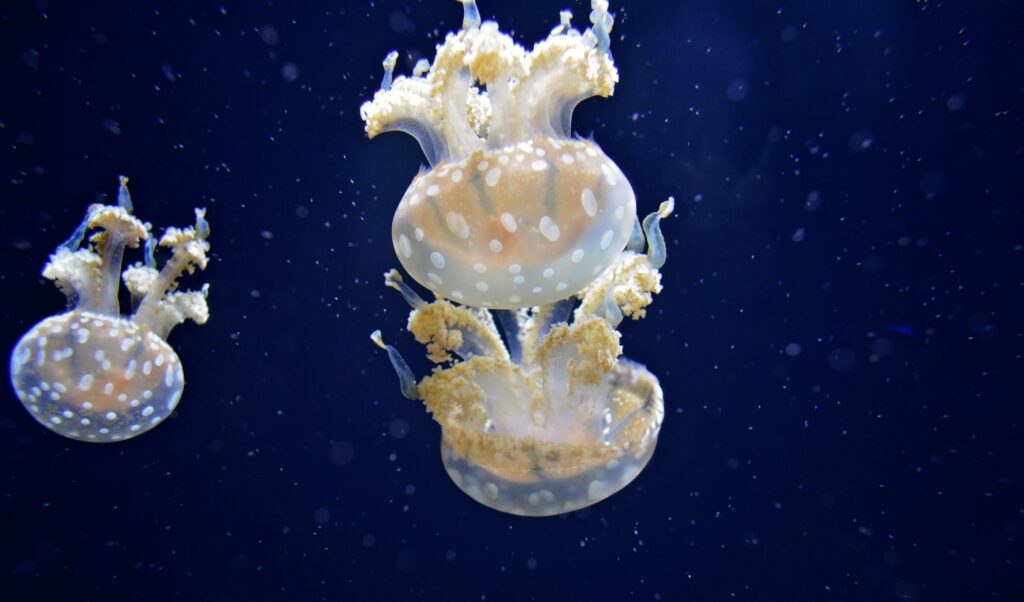
Density of jellyfish in an aquarium
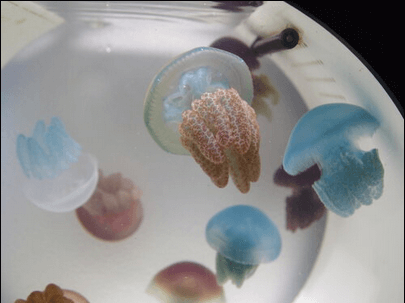
Jellyfish can be kept in high density as long as the water quality is maintained within the right range. You may see a lot of jellyfish (usually moon jellyfish) congregating in one aquarium at public aquariums. However, this type of display is only possible for jellyfish which feed on small plankton with short tentacles, such as moon jellyfish, flame jellyfish, blue blubbers, hydrozoan or comb jellyfish.
For the jellyfish which feed on larger animals or other jellyfish with long tentacles, such as sea nettle or lion’s mane jellyfish, it is recommended to keep them in much lower density. Those jellyfish look most beautiful when their tentacles are fully extended.
The tentacles retract when they touch anything such as a tank wall or other animals including the same kind. So if you keep them in small tank, or with too many of them together, they will not have the chance to extend their tentacles fully. It seems to limit their growth and affect their health, and also they often get tangled if too many are kept in the same aquarium. Ultimately one jellyfish per tank is the best way to show the true beauty of those long tentacle jellyfish
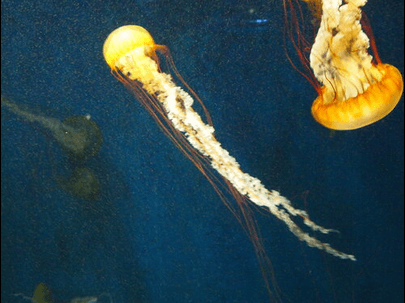
Summary
To summarise, let us get back to the first question. Is it easy to keep jellyfish? I would probably say it is not too easy. It is not because they are complicated to look after, but more because the environment for keeping jellyfish has not been fully established yet. For example, if you would like to set up a reef aquarium, it is complicated but you can find all you need from an aquarium shop including coral, liverocks, fish, foods, lights, chemicals, tank, all equipment and husbandry information. If you would like to set up a jellyfish aquarium, you can probably find where to buy jellyfish aquariums, but you will need to find where to buy jellyfish and jellyfish foods, and almost no one can tell you exactly how you can take care of them.
One day in the near future, we hope that you can find various jellyfish in aquarium shops where you can also choose different jellyfish aquariums, equipment, food and all supplemental chemicals. Exotic aquaculture will keep working on developing and sharing the equipment, food and husbandry methods to everyone to enjoy keeping this beautiful marine creature.
Written by: Toshihiro Yoshida, 16 Jun. 2020
